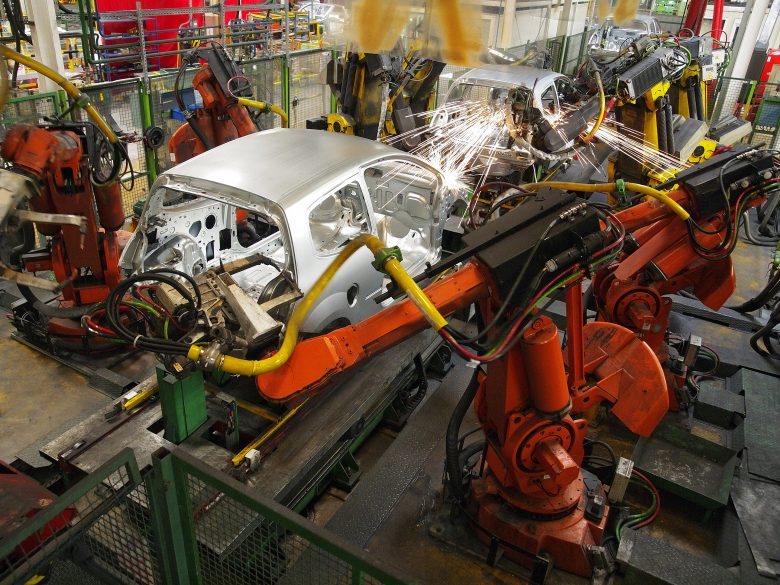Since the first assembly lines were developed, automation has become increasingly common in production and manufacturing of everything from food and small machine components to cars. Machines have taken over a huge number of tasks and, from a financial perspective, it’s not surprising. Machines don’t get sick, they don’t need vacations and they don’t get injured.
However, there are also concerns that robots and workplace automation might create a hazard to the surrounding workers. There are many guidelines and requirements to owning and operating automatic equipment, and to assessing the risks involved in such operations, which can help employers ensure a safe work environment for their workforce.
The most common hazards
According to OSHA, “many robot accidents do not occur under normal operating conditions but instead, during programming, program touch-up or refinement, maintenance, repair, testing, setup, or adjustment”. More specifically, OSHA identifies seven main potential hazards to humans working with robots:
- Control errors – These are faults within the control system, software, electromagnetic interference, and radio frequency interference. If the control system has a fault, this can create erratic behavior or an increase in the hazardous energy potential of the machine.
- Unauthorized access – Unauthorized entry into a safeguarded area by someone who is unfamiliar with the safety hardware can easily result in a serious injury.
- Mechanical failures – Mechanical issues can result in faulty or unexpected operation of the robot. These types of failures are unpredictable and potentially dangerous.
- Environmental sources – Some factors can’t always be anticipated, such as sudden environmental causes of electromagnetic or radio-frequency interference that can influence the robot’s performance. It’s important to plan for events such as power surges or power loss when designing and implementing automation in the workplace.
- Power systems – Robots’ power sources can be disrupted and lead to malfunctions. For example, pneumatic, hydraulic or electrical power sources with malfunctioning control or transmission elements in the power system can disrupt electrical signals to the control and/or power-supply lines. This can become the source of an energy release and cause electrical shocks. The risk of fires can also be increased due to electrical overloads, especially when they occur in robots that make use of flammable hydraulic oil.
- Improper installation – When an industrial robot is being installed, it is critically important to do it correctly. Incorrect installation can result in different hazards depending on the specific variance from the original design. This is why the design, installation requirements, and layout of equipment and utilities of a robot or automation system have to be followed to the letter.
- Human errors – This cause of serious incidents covers a wide range of mistakes: faulty programming, interfacing, maintenance, or incorrect activation of the “teach pendant” or control panel, among other issues. In addition, operators or other workers may put themselves in danger due to over-familiarity with the robot or fail to recognize line-of-fire risks associated with the robot’s motions.
Two categories of robot safety
OSHA’s list of potential sources of hazard can be easily divided into two categories: mechanical/physical factors and human factors. There are many ways to address the former, such as ensuring proper programming; safeguarding against power surges; applying fixed guards, placards, stickers, or warnings; and adding barriers such as a fence or plexiglass.
Guards should be in place at all times and LOTO procedures must be followed during maintenance. It is also a good idea to maintain emergency operational controls of robots. This provides workers with the ability to initiate a shutdown in the event of an issue.
Addressing the above physical hazards is vital to creating a safe work environment for employees in car manufacturing and other mechanized industries. However, even the safest piece of equipment can be used incorrectly by someone who is fatigued or complacent. Humans are fallible and can miss or ignore necessary steps despite training or physical safety precautions. Not only that, but humans relying on machines too much can lead to complacency and cause more accidents due to inattention and trust in the machine’s infallibility.
Robots themselves are programmable and most of their actions (if unaffected by malfunctions and other mechanical failures) can be easily predicted. This is why it’s important to provide human factors training to any workplace that has humans working alongside robots. This training can teach workers the right techniques to approach physical hazards and their own states of mind, such as frustration or rushing. Knowing to recognize such states and having the right tools to address them can significantly reduce the number of workplace injuries. It’s also helpful in ingraining the idea that employees should never use machinery they don’t understand or have not been trained to use.
Each of the potential hazards noted above can have disastrous consequences, but they are all preventable—so it’s important for employees to be educated in the system’s use and for the robots to be properly programmed and installed. Performing a risk assessment before the robot is operational can also contribute to a safer and more productive workplace. But it mustn’t be forgotten that although robots can be programmed, humans can’t, which is why comprehensive training in physical and human factors is so important for employees who work alongside robots and other forms of automation.

